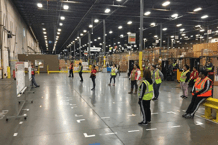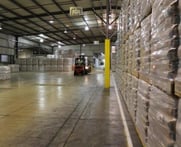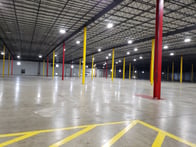Purchasing a warehouse or leasing warehouse space for your company can provide you with many different benefits:
- It can give you a place to store overflow at your facility
- You can build inventory off-site
- Allow you to access storage for the products you sell frequently.
If you don’t have the capital at this time, scroll down to Consider partnering with a 3PL.
Before you decide to obtain a warehouse, consider the following:



How much will it cost?
While the idea of leasing a warehouse might sound great at the time, you need to make sure it’s justified and you can afford it. Rates for warehouses will vary depending upon where a warehouse is located and how much square feet is available. Also, will your warehouse be required to have regulated temperatures or rail service?
Be certain you have adequate funding for the proposed location; fundamentally, you may think you have more revenue bandwidth than you actually have.
Location
Location is likely the most important factor when it comes to deciding where to store your product. You’ll need to think about a location’s proximity to your customer base as well as your suppliers. For most businesses, that means the coasts. That’s because the population is six times denser on the nation’s coasts, and many businesses receive products from overseas suppliers, which means choosing a coastal location can yield significant savings on shipping costs. Also, a Midwest location like Columbus, OH metro area is within a one day drive time of 45% of the U.S. population and 36% of the U.S. manufacturing capacity. As your business grows, you may find that there are some big upsides to splitting your inventory between two or more RDC’s (Regional Distribution Centers). A fulfillment strategy will largely depend on where the bulk of your customers are.
Square Footage
How much space you require depends on a few key parameters, the most important of which is:
1. The size of your product—It’s the difference between storing ten-ton paper rolls or packaged OEM aftermarket parts.2. The nature of your product also determines how you organize it within the warehouse.One common option is stacking inventory from floor to ceiling using metal racks to save storage space, which is ideal for pick and pack items. The alternative is to organize inventory on the floor, which is suitable for a product that is packaged in stackable pallets, but the downside is it occupies more space.
3. Another essential consideration is sales volume and the rate of product turnover. For industries such as technology and consumer electronics, where demand is consistently high and inventory moves in and out monthly, racking may not be worth the initial investment and effort. For products that sit longer because demand is spotty or linked to seasonality, racks may make more sense.
Mobile Equipment and RF Scanners
Unless you plan on unloading and loading trucks by hand be prepared to invest in a number of forklifts which will depend on how many dock doors the warehouse will have.
Forklifts are heavy and robust pieces of machinery that can do the job of many seasoned warehouse teams and much quicker. Buying or leasing a forklift usually comes with a guarantee and you might consider outsourcing a maintenance company to regularly check the forklift for safety and efficiency levels; doing this can ensure your forklift operates properly and has an overall longer life. Also, research your propane vendors for best pricing. Unless you plan to rely on old school tracking of inventory, using an RF scanner allows for more accurate inventory control and status updates. When it comes to inventory management, inventory analysis can halt production if Warehouse Managers have to wait for complete reports, or for paper documents to be processed.
How will you incorporate transportation services with your warehousing?
Unless you own or operate a fleet of LTL (Less than Truckload) or FTL (Full Truckload) trucks, you may find that outsourcing freight services may be your most viable option if you don’t have a lot of capital left over. Transportation services required might look something like this:
- Dedicated plant – to – warehouse shuttles
- Delivery of Vendor just-in-time supplies to the warehouse
- Dedicated shuttle delivery of warehoused goods to your customers
Is the warehouse close to roads, highways, and other forms of transportation?
The warehouse will need to be located near roads, and highways. You may also need to ship items, so having your warehouse located near a railroad, port, or airport could also prove to be the right move for your company. Regardless, you should take the time to research the surrounding transportation options. The greater the distance between your fulfillment warehouse and your customer, the higher the shipping cost. The answer to this dilemma is a thorough understanding of your business, including seasonality and patterns in sales across regions.
Will you be able to hire local experienced people for day-to-day operations?
Once you have obtained a warehouse for your company, you will then need to fill it with local, experienced employees who can maintain the operation. If the warehouse is located in or near a major city, this shouldn’t be a problem, but if the warehouse is in a more rural setting, finding employees could prove to be more difficult. You should look at the local job market before agreeing to lease or buy a warehouse, or consider a 3PL to operate your warehouse.
Consider partnering with a 3PL
If you have very little capital and absolutely no experience at executing the above mentioned, your best option might be to partner with a 3PL (Third-Party Logistics). A great 3PL fulfillment provider can help you review your past regional distribution and provide a strategic plan.
Do you need assistance tracking down the right warehouse for your company? Spartan Logistics owns and operates up to 17 locations that are within a one-day truck delivery time of most of the country. We also know that our existing facilities might not always meet the needs of every customer that comes to us for service. This is why we offer a customized “build-to-suit” opportunity for our clients. Spartan aids in selecting or partnering to strategically place a warehouse location that is optimal for distribution. Contact us today to hear more about the warehouses we have available at this time. We work with each client to develop the best fulfillment strategy that best supports their business.
Topics: Supply Chain Strategy, Logistics News, Regional Distribution Center

